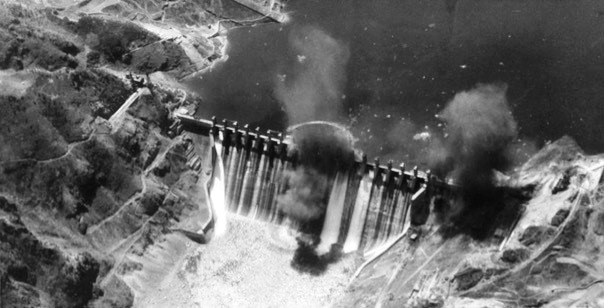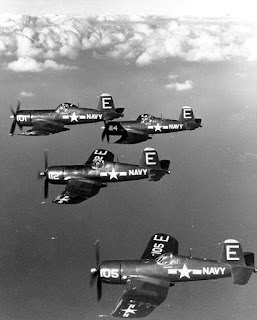From the Korean War (1950-1953) we know some memorable actions: the resistance of the perimeter of Pusan, the landing in Inchón, the fight in the Chosin reservoir, the battles of positions in the 38th parallel, the first fighter fights to reaction or the Armistice of Panmunjong. What is not so well known is that it was also a war at sea (the same landing of Inchón is a naval operation) or that the perimeter of Pusán could be maintained thanks to the cannons of the cruisers and battleships that were on the coast, or of the aircraft on board. It is a subject that has not received the attention it deserves, especially since the larger naval operations of World War II overshadowed those of Korea.

All this and more can be found in the book The War on the Sea in Korea published in 1957, a few years after the war ended, based on the first complete report on the role of the United States Navy in the Korean conflict. Captains Malcolm Cagle and Frank Mansonthey demonstrate how it would have been impossible to maintain the war without the United States Navy, since the control and control of the sea around Korea allowed the United Nations forces to stop the "communist invasion" and maintain the armies on the ground with a logistics that extended in some cases from the other side of the world. Finally, they defend that the forceful performance of the Seventh Fleet served to dissuade the emerging communist powers from expanding the war in other parts of the Pacific. This last part has to do with the idea that developed in the early 50's to dismantle the armed forces under the idea that, in a nuclear conflict, with only nuclear bombers would be enough to win the wars. A) Yes,
We will see inside this immense work (more than 500 pages) an action that caught my attention and is that in this war where the North Korean forces did not have virtually any naval unit (I leave some sampran in mining operations of the coast) it seemed that the use of torpedoes was relegated to practices and little else. And after the Second World War, the first and only time torpedoes were used in Korea was to attack, AN EMBALSE!
Let's recap, by the end of the 1950s the forces of the South had reached the almost border of China and there, in the coldest winter that was remembered were defeated by the Chinese and North Koreans and forced to retreat below the 38th parallel. There is the reservoir of Hwachon , which held by the North Koreans allowed them to control the level of the Han and Pokhan rivers (either by flooding them by opening the floodgates and thus preventing the southern armies from crossing the rivers, or by closing and lowering the level of them to be able to easily wade through them).

The use of the currents of the rivers is not foreign to us, our thirds must have seen them with strategic floods that the Dutch made to stop or bag the Spanish soldiers (the most remarkable the so-called miracle of Empel , where the shot came out by the butt)
At the end of April 1951 it seemed that the North Koreans prepared an attack, and they were closing the floodgates of the dams to be able to go over the rivers. Given this, the VIII US Army in Korea asked the air force to destroy the floodgates of the reservoir, something that was tried with several B-29 without success (already in World War II the English achieved a success by bombing the dams of the Ruhr basin with Dambuster pumps of about 3 tons)

Seen which, they went to the Navy so that their embarked planes tried it. The mission was not simple, the measures of the gates were impressive (6 meters wide, 12 high and 75 cm thick) all surrounded by cannons and anti-aircraft machine guns. The mission was entrusted to the Princeton aircraft carrier, to its combat squadron VA-195 commanding by Corvette Captain Harold G. Carlson , and the navy decided that the most suitable weapon for this mission would be the torpedo . Soon the entire squadron got down to work, and in the meantime some Skyraiders were sent to test 2,000-pound bombs against the floodgates, and some Corsairs softened the anti-aircraft defenses.
In the end, this mission was not successful , but we had to try it because, the idea of the torpedoes was not as simple as we can imagine. The reservoir is surrounded by mountains, which limited the attack to one pair of planes at a time, while the rest should wait their turn. This rectilinear pass was very short, with the problem of regulating its speed in the air so that the fall of the torpedo was accurate (unfortunate situation in an environment surrounded by anti-aircraft guns pointing at you) which required great accuracy.The torpedo could not touch the bottom of the reservoir, and it had to be far enough so that it had enough power to activate.

The attack was carried by 8 Douglas A-1 Skyraiders under the command of Commander RC Merrick, and Lieutenant Commander Carlson , all armed with a graduated torpedo to make the race on the surface, and escorted by 12 fighters of the same squadron armed with 100 and 500 pound pumps with VT fuses (proximity) to cancel antiaircraft weapons. This whole team took off at 11:30 on May 1, being a success, since 6 of the 8 torpedoes toured the planned race, destroying a complete gate, and the other with damages and a 3 meter gap. After this, the waters jumped from the reservoir and paralyzed the imminent North Korean action. A short time later, the reservoir was recovered by the North American armies. In honor of this action, the VA-195 embarked was renamed the "Dambusteros" (in honor of the bomb that we mentioned).
Respuestas